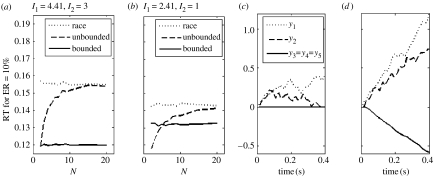Figure 5.
Performance and dynamics of choice models with only two accumulators receiving inputs. All models were simulated using the Euler method with Δt=0.01 s. (a,b) Decision time for a threshold resulting in an ER of 10% of different choice models as a function of the number of alternatives N (shown on x-axis). Three models are shown: the race model, the unbounded (i.e. linear) LCA model and the bounded LCA model (see key). The parameters of the LCA model are equal to w=k=10. The parameters of the first two inputs were chosen such that c1=c2=0.33, I1−I2=1.41 (values estimated from data of a sample participant of experiment 1 in the study of Bogacz et al. (2006)), while the other inputs were equal to 0, I3=⋯=IN=0, c3=⋯=cN=0. The panels differ in the total mean input to the first two accumulators: in (a) I2=3, while in (b), I2=1. For each set of parameters, a threshold was found numerically that resulted in ER of 10%±0.2% (s.e.); this search for the threshold was repeated 20 times. For each of these 20 thresholds, the DT was then found by simulation and their average used to construct the data points. (Standard error of the mean was lower than 2 ms for all data points hence the error bars are not shown.) (c,d) Examples of the evolution of the bounded LCA model (c) and unbounded LCA model (d), showing yi as functions of time. The models were simulated for the same parameters as in (a), and for N=5 alternatives; (c) and (d) were simulated for the same initial seed of the random number generator hence in both cases the networks received exactly the same inputs.

